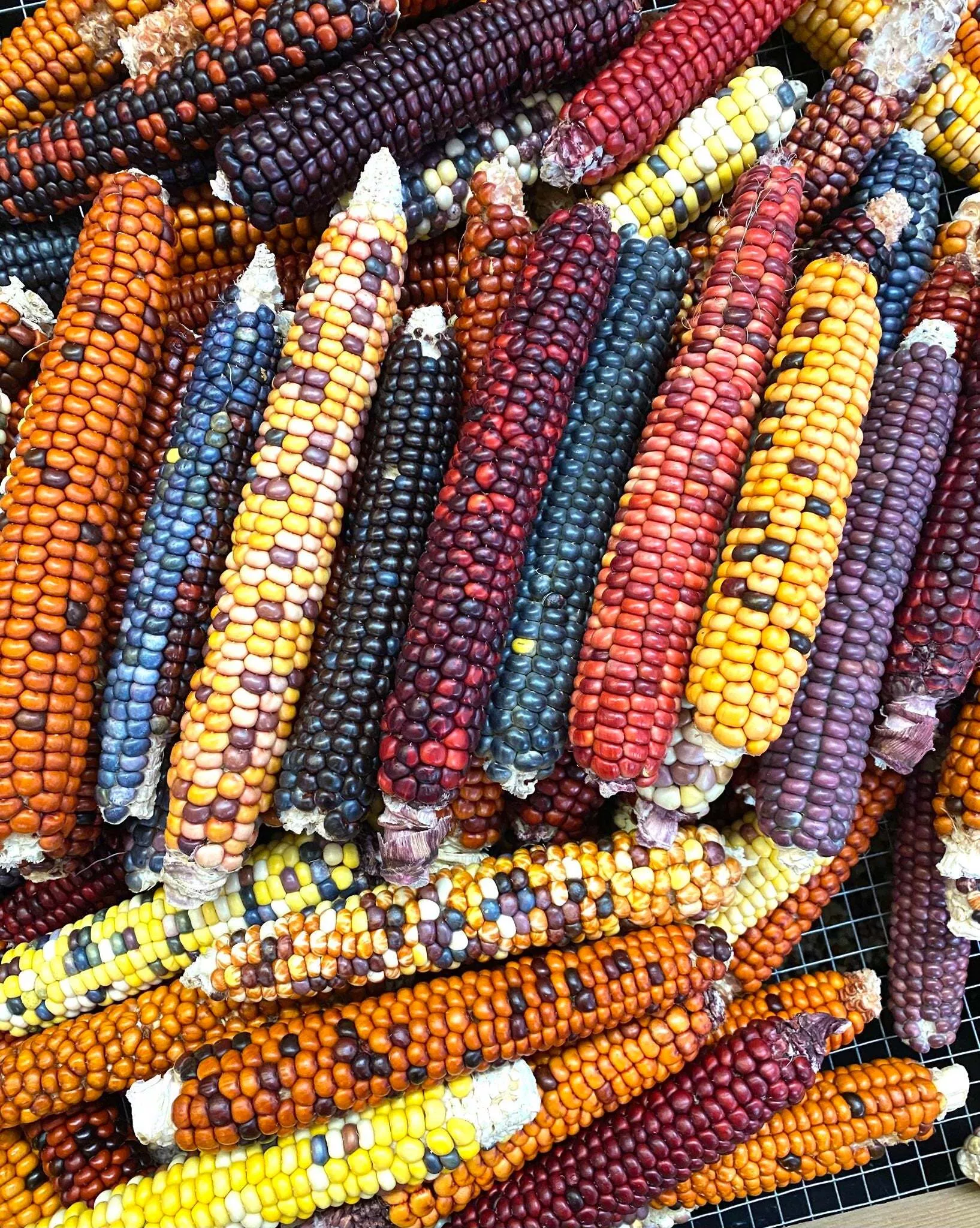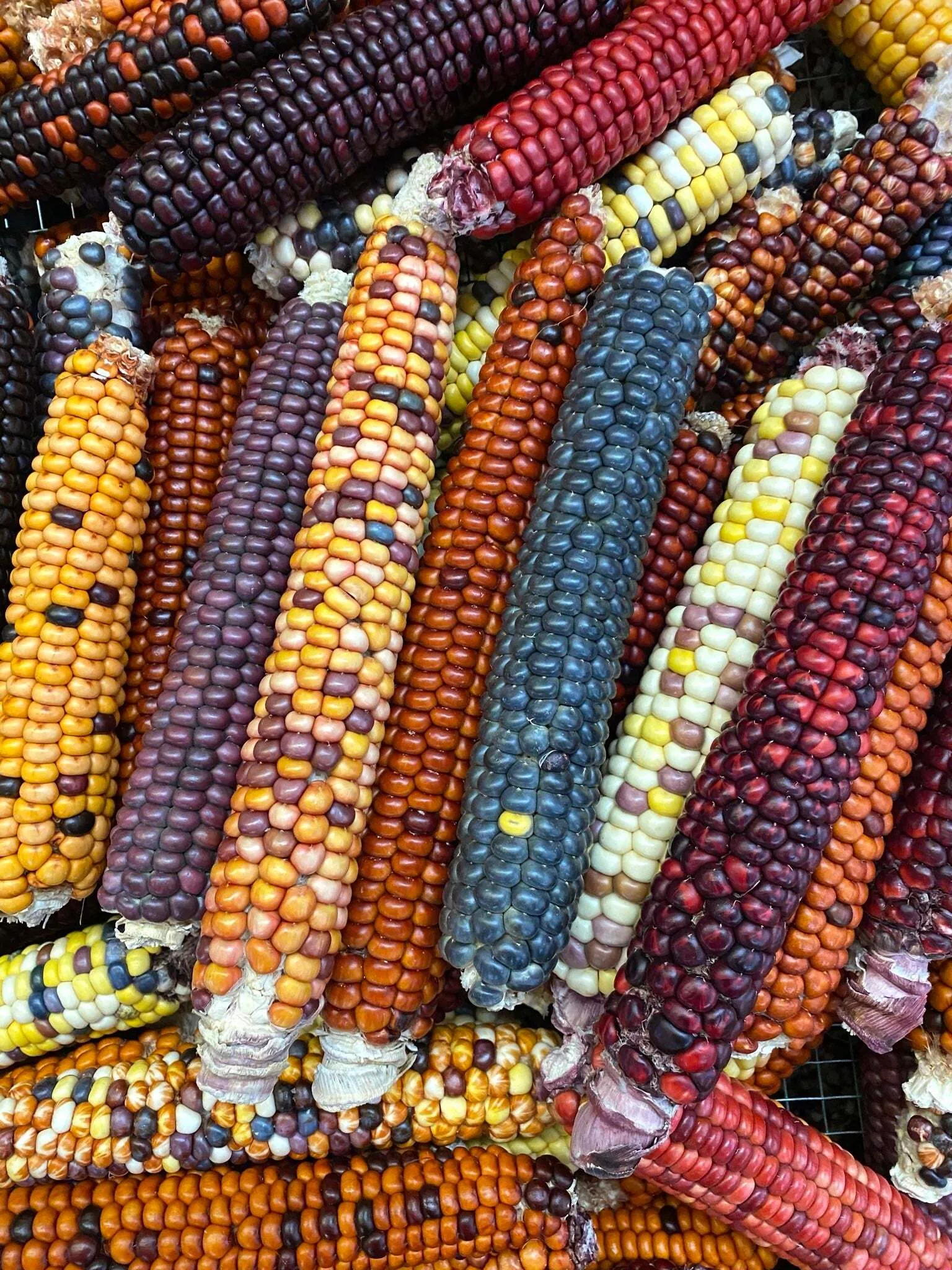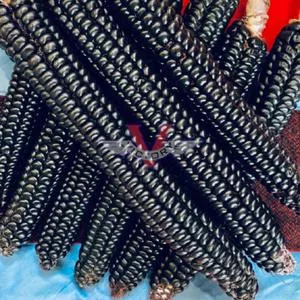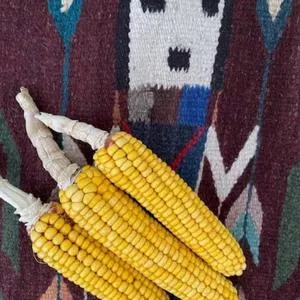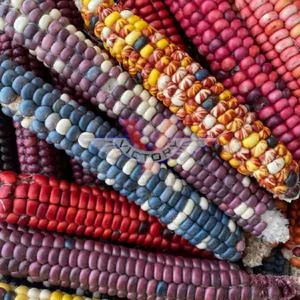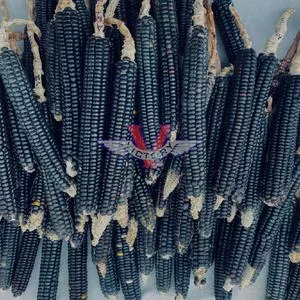

Painted Mountain Flour Corn - 12 row
Price: $5.00
SKU: 31404701Wider larger cob selection for those wanting to boost grain yield. Often 12-rows of kernels. Selected from Dave's regular Painted Mtn fields. Limited amount sold only at Victory Seed.
Dave tries to grow the narrower 8-rowed cobs, like the Indians did, for faster drydown, which is critical when a fast maturing crop is needed. But, a smaller percent of cobs have more rows, and are being sold separately. Recommended for a warmer climate when they will have longer to dry on the plants.
80 to 100 days - The stalks are efficient, hardy, small, average about five feet in height, and produce seven-inch long, beautiful ears. 'Painted Mountain' corn plants can vary from four to six feet tall and the ears from six to twelve inches, depending upon fertility and water.
Some of the husks are purple or red, while most are a typical pale tan color, but inside, every ear is different. 'Painted Mountain' corn has been primarily sold over the years as an ornamental or decorative corn for variety and has become a hit at farmer's markets. It produces some of the brightest colors of any corn making harvest time exciting and fun. Harvest time is exciting - like opening presents. Peeling back the husks reveals the surprising color combinations.
Along with its beautiful, obvious ornamental value, 'Painted Mountain' corn is a multi-purpose, highly nutritional food corn. The kernels have soft flour starch that grinds up wondrously for cornbread. (You can learn more food uses below.)
The seed we sell is produced by its developer. Since 1970, Dave Christensen of Big Timber, Montana (Seed We Need®) has been continuously developing and refining this amazingly diverse corn variety. He has made it his life's work. We purchase our seed stock directly from Dave so by purchasing these seeds for your own garden, you are not only helping to support the seed variety preservation work of the Victory Seed Company, you are directly supporting another small, seed preservationist.
He started by rescuing about one-hundred Native American heirloom corn varieties. These corns had survived for centuries, under the most extreme environmental challenges, from cold springs to summer drought. These genetics result in the extreme hardiness of 'Painted Mountain' corn. (You can read more about his work below.)
Dave tells us that, "This nutritious corn is now being grown by people on every continent in the world. It is helping to prevent many people from starvation. It is a diverse, open-pollinated gene pool, capable of adapting to various locations. Because of its genetic diversity, it can be adapted to locations. With climate change, 'Painted Mountain' should be in everyone's survival seed bank." Each ounce contains approximately 85 seeds.
Sow seeds about 1½ to 2½ inch deep, 3 to 4 inches apart, in rows spaced 24 to 30 inches apart. Thin to 6 to 12 inches apart.
Planting Instructions:
'Painted Mountain' is the most cold-hardy corn available for early spring planting. Unlike the common practice of waiting until all danger of frost has past, it was developed to survive planting in the cold, early spring soil. Developed at a 5,000 foot elevation in the mountains of Montana, it is bred to sit in cold, wet soil emerging with amazing vigor when it warms up.
Dave recommends planting by May 15 in the highest elevation where freezes and frost continue into June. In warmer climates plant it earlier. He tells us that, "You will not find anything on the market that matures faster." In fact, "Its ability to go into cold soil and to mature fast makes it possible to grow it near neighbors with GMO corn and minimize contamination. 'Painted Mountain' will usually be done pollinating before commercial corns start spreading their pollen."
If you grow without irrigation, it is good to get the corn growing early so that it is well established before mid-summer heat and drought hits. In Harden, Montana we plant on April 15th and harvest it around August 15th as dry grain.
As far as spacing of plants goes, you can do anything with it that you want. There are many ways you can space it, some better than others, but the instructions can get too complicated. The shorter the season the more space it should be given. I would caution that the plants are short and should not be planted where they will be shaded out by taller plants.
I plant my large, dryland acreage with twelve inches between kernels in rows spaced three feet apart. If you irrigate, you can space them closer together. The most common error people make is planting them too closely.
If planting using the "three to four kernels in a hill" method, make sure there is plenty of space between the hills so the plants get water and sunlight. Hill planting has an advantage for survival because you can carry a bucket of water to them. And understand that the kernels are planted on level ground, or in an indentation to catch rain water, and they are only "hilled-up" later in the growing season to lock in the moisture. Do not plant kernels in a mound or hill at the start; the roots will be on top of the ground level. You want the roots to go deep to get water and to support the plant.
All corn varieties need to be planted in a block so that there are neighbors for pollen on all sides. If you plant in a straight row the wind can blow all the pollen away.
Harvest Information:
Pick the ears for dry grain or decoration when the husks are dry and the kernels are hard enough that you cannot make a dent in them with your fingernail. Many people pick the ears too early when kernels are still soft. If this is done they shrivel up and shrink and their beauty is destroyed. They cannot finish maturing once they have been picked.
Even though the ears look dry, there remains moisture deep within the cob. If you were to enclose them in a box, the moisture would cause them to sour and mold. You may let them dry longer on the plants if neither weather nor predators are damaging them. Otherwise hang them up or lay them out in the open until they are completely dry inside.
The following information is provided by the variety's developer, Dave Christensen:
A significant amount of customers buy it for grain to feed their families. It can be made into corn bread and any number of the hundreds of foods you can make out of flour corn. 'Painted Mountain' has a soft flour starch which grinds quickly into a soft fluffy flour. Soft flour starch is the most useful of all types of starch for human and animal food. When making corn bread you do not need to add soft white wheat flour to it because it is already soft. You can use it 100% and make the tastiest and richest cornbread ever. When you make cornbread the blue will dominate and you will have blue cornbread.
Other food uses are: hominy, soups, stews, corn chowder, boiled and fried in bacon, pasole, and parched corn for a trail or snack food. Grind it coarse and make mush or polenta. Add other things for flavor. And yes, you can pick it fresh for corn the cob or for roasting ears . It will not be as sugary as sweet corn, but is more enjoyable than field corn.
The soft flour of 'Painted Mountain' makes it a challenge to make tortillas. Those who make tortillas boil it before grinding it in the traditional method. The hard starch of flint corn is preferred in making tortillas gummier and binds better. But flint starch is very hard to grind. Flour starch has many more uses.
ADVANCEMENT OF 'PAINTED MOUNTAIN' CORN
I have been working very hard to improve the plant's architecture, its "standability," stress hardiness, uniformity, yield, nutrition, as well as its beautiful color diversity. I do this advancement work without pay. I live on a shoestring because the development of 'Painted Mountain' is saving lives every day.
When people hear that I do "breeding," they are conditioned to suspect that I am making 'Painted Mountain' into GMO corn. Not so! That is ridiculous.
I cannot afford that million dollar technology. Besides I am breeding Native corn so that people have a healthy alternative to GMO corn. Heirloom corn is the natural alternative and antidote to GMO corn. I only use old-time, natural selection and breeding techniques [classical breeding]. I use a labs to test for nutrition to identify the most nutritious lines.
My 'Painted Mountain' is grown too far away from any other corn to be contaminated by other pollen. 'Painted Mountain' corn is grown in remote places of Montana, where the climate is too short and harsh for other corns to grow.
The 'Painted Mountain' corn that I sell commercially is all grown by my partner Bob Quinn on his organic farm in Big Sandy, Montana. We send out an organic certificate to our customers every year. Two of my customers test my crop every year to prove that there is no GMO pollen contamination.
The small efficient plants are not built for machine harvest. Customers who buy large amounts need to understand that it is not machine harvestable. If you are expecting to harvest it with a combine, you will be disappointed. Machine harvesting requires tall strong-stalked modern plants. 'Painted Mountain' corn's small plants must be hand harvested. The plants put all their energy into the grain, and not into tall strong stalks.
This is actually quite beneficial. Because they do not have to grow tall, woody stalks, they take less nutrients out of the land. And the efficient plants endure hardship and stress and still produce grain. Modern people familiar with industrial machine harvestable corn do not understand the value of the small plants. But small plants feed people on marginal soil, where industrial corn fails and people starve.
Those who do not understand the ecology of efficient plants will eventually be forced to learn, as global warming exposes the weaknesses of our ecologically un-sustainable industrial agricultural methods.
Many farmers grow 'Painted Mountain' corn to be used as their family's grain. They sell some at Farmer's Markets. Many feed the rest to livestock or poultry. You can pick the best ears for yourself and let the animals go in after and eat whatever you don’t want to pick.
In the 1950's some farmers grew fifty acres of Indian corn. In the Fall they let herds of cattle into the fields to eat the grain and be fattened for market. This can actually be done when the grain is still slightly moist and there is zero labor involved in harvest.

